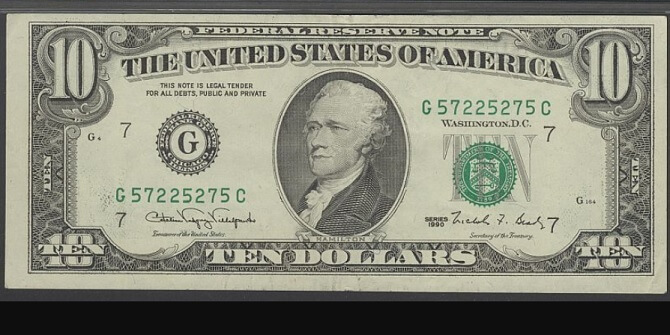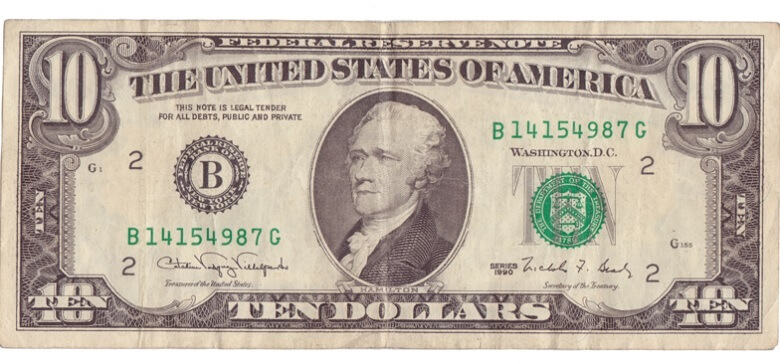1990 10 Dollar Bill Value – Have you ever wondered if the old 1990 10 dollar bill tucked away in your wallet or hiding in a forgotten drawer is worth more than its face value? If so, you’re not alone.
Many people are curious about the worth of their older currency, especially the 1990 10 dollar bill. With its unique design and historical significance, it’s natural to wonder if this bill has any extra value.
In this blog post, we will dive into the world of currency collecting and determine the 1990 10 dollar bill value.
So, let’s find out if your old 10 dollar bill is worth more than you think!

The Historical Of The 1990 $10 Dollar Bill
The value of the 1990 10 dollar bill, most of them aren’t worth much more than their face value. However, there is one exception – the star notes. These star notes are replacement bills that were printed by the United States Federal Reserve, and they are more rare and thus more valuable.
But what exactly are star notes? Well, you can easily identify them by looking at the end of the serial number on the bill. If there is a star symbol, then you have a star note.
These star notes were printed to replace any bills that were damaged during the production process.
In the next sections, we will explore the specifications of the 1990 10 dollar bill, its value, and how to determine the grade of the bill.
1990 10 Dollar Bill Specifications
The 1990 10 dollar bill has some interesting specifications that are worth exploring.
The denomination of this bill is $10.00 USD, meaning it has a face value of 10 dollars. It is categorized as a Federal Reserve Note, which is the most common type of currency in the United States.
The signature combinations on this bill are one: Villalpando and Brady, representing the individuals who served as Treasurer of the United States and Secretary of the Treasury, respectively, during the time the bill was in circulation. This particular bill belongs to Series One of the 1990 bills.
Understanding the specifications of the 1990 10 dollar bill can help you identify and evaluate the authenticity of your bill.
1990 10 Dollar Bill Value
Well, the truth is, most of these bills in circulated condition won’t fetch a higher price than their face value of $10.
However, if you happen to have a bill in better condition or a star note, you might be in luck!

In better condition grades, the 1990 10 dollar bill can sell for a premium. In fact, in extremely fine condition, these bills are worth around $12.50. This means that if your bill is still bright and crisp, with only minor creases or folds, it might have some extra value.
But what about star notes? These replacement bills, printed by the United States Federal Reserve, are more rare and thus more valuable.
If you come across a 1990 10 dollar bill with a star symbol at the end of the serial number, hold onto it!
These star notes can be worth around $20 in extremely fine condition and even more in uncirculated condition with a grade of MS 63.
You never know, your old bill might just be worth more than its face value after all.
1990 10 Dollar Bill Star Notes
Star notes are a fascinating aspect of currency collecting, and they can hold some hidden value.
These star notes were printed by the United States Federal Reserve as replacement bills, and they are more rare and thus more valuable than regular bills.
To determine if you have a star note, simply look at the end of the serial number on your 1990 10 dollar bill – if there is a star symbol, then congratulations, you have a star note!
- In extremely fine condition, 1990 10 dollar star notes are worth around $20. This means that if your note is in excellent condition with minimal signs of wear and tear, it could fetch you a decent sum.
- In uncirculated condition with a grade of MS 63, the price can go up to around $50-60. These star notes are sought after by collectors and can make for a great addition to any collection.
It could be worth more than you think!
1990 10 Dollar Bill Grading System
When it comes to the grading system for the 1990 10-dollar bill, there are two main categories: extremely fine and MS 63 choice uncirculated.
An extremely fine note is one that shows small signs of having been in circulation. While it may have a bright appearance and almost all of its original crispness, there may be one or two minor creases or folds. However, there should be no stains, discolorations, or tears.
In other words, it should still look relatively new and well-preserved despite its circulation.
On the other hand, an MS 63 choice uncirculated note is in pristine condition with no signs of ever being in circulation. It still has its original crispness and maintains its overall appearance. Additionally, it should be well-centered on the bill, meaning that the design and text are balanced and aligned properly.
Understanding the grading system is essential when determining the value of your 1990 10 dollar bill. A note in extremely fine condition is likely to be worth more than one that shows signs of heavy circulation or damage.
Collectors and buyers are more interested in bills that are closer to their original, new condition.
Where and How to Sell Your Valuable $10 Bill
Now that you know the potential value of your 1990 10-dollar bill, you might be wondering where and how to sell it.
- The first step is to determine whether your bill is genuine or fake. Counterfeit bills can be a significant concern, especially with older currency. To ensure the authenticity of your bill, it’s always recommended to consult with a currency expert or reputable dealer.
- Once you’ve confirmed that your 1990 10-dollar bill is real, there are a few different avenues you can explore to sell it.
- Online marketplaces such as eBay or Etsy offer a platform for selling valuable currency. You can list your bill and set a price, or even auction it off to potentially increase its value.
- Another option is to reach out to currency dealers or collectibles shops in your area. These experts are knowledgeable about the market and can offer you a fair price for your bill. They may even be interested in purchasing it for their own collections.
- You could consider attending currency shows or auctions, where collectors and dealers come together to buy and sell currency. This can be a great opportunity to showcase your 1990 10-dollar bill to potential buyers who are specifically interested in currency collecting.
Remember, the key to successfully selling your valuable $10 bill is to do your research, verify its authenticity, and find the right platform or buyer who is willing to pay a fair price.
Conclusion
Most 1990 10 dollar bills may not have a significant increase in value, there are some exceptions that are worth keeping an eye out for. The star notes, in particular, can fetch a higher price due to their rarity.
These replacement bills printed by the United States Federal Reserve are sought after by collectors and can add value to your collection.
Just make sure to do your research, verify the authenticity of your bill, and find the right platform or buyer who is willing to pay a fair price.
So, whether you’re a collector or just curious about the worth of your old 1990 10 dollar bill, remember to keep an eye out for star notes and consider the condition and grading when determining its value. Your old bill may hold more value than you think, making it a fascinating piece of history and potentially a valuable addition to your collection. Good luck with your sale!
See Also About Other $10 Bills: